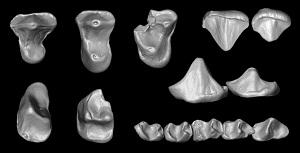Digital wellbeing should be a public health priority for the Arab region
21 October 2025
Published online 3 June 2010

The discovery of an ancient primate that probably lived 37 million years ago in Africa has scientists baffled. The newly reported Nosmips aenigmaticus just does not fit into the evolutionary tree of primates.
The discovery of 12 teeth in northern Egypt, reported in the Proceedings of the National Academy of Sciences of the United States of America1, means that we have no idea what the creature's body actually looked like. However, certain diagnostic features of the highly specialized teeth are found only in primates.
"Presumably, Nosmips is difficult to place because it is likely to be the first known representative of a very ancient African primate lineage. One that had, prior to 37 million years ago, probably been evolving in Africa for millions — perhaps tens of millions — of years," said Erik Seiffert, who is the lead researcher and an assistant professor of anatomical sciences at Stony Brook University, New York, in the United States.
Primate evolution in Africa and Arabia during that ancient period of history is poorly documented, explained Seiffert. That is probably why Nosmips was not previously identified.
It could well be that would force us to rethink some of our assumptions about primates.
Three main lines of primates were previously identified in the region: monkey-like primates, lemur-like primates and tarsier-like primates. During the Eocene epoch (56–34 million years ago), the evolutionary lineage leading to Nosmips probably trod its own unique path, producing strange features that are different from those of all other known fossil primates.
The new discovery is not the first oddity to arise in the evolutionary map. A genus called Rooneyia, which was found in Texas in the United States, has scientists divided: some think it is a monkey, while others believe it is related to lemurs.
"The basic evolutionary framework that has been built up on the basis of what we know from the genetics and anatomy of living primates is still very sound and has stood the test of time," stressed Seiffert. "We would just like to know where these very fragmentary fossils might fit into that framework."
"These mystery fossils must have something important to tell us about primate evolution," he added.
Teeth are usually well preserved, as they are the most durable parts of the body. The 12 fossilized teeth can give a general idea about the diet and lifestyle of Nosmips. Three-dimensional reconstructions of the teeth show that the primate had simple upper molars, combined with enlarged and elongated premolars. Unlike other primates' teeth, its premolars are not simple: they have taken on the form of molars themselves.
The scientists compared the odd structure of the teeth with those of other living primates. "We found that Nosmips was most similar to prosimian primates with varied diets — those that ate fruits, leaves and insects," said Seiffert. Microscopic pits on the teeth support the hypothesis that this primate ate fruits, the hard seeds of which probably caused the dents.

Erik Seiffert, Stony Brook University
The 12 fossilized teeth from multiple individuals were collected over a period of 9 years of intensive excavation in the Fayum depression, which is an area ~75 km south of Cairo and west of the Nile valley. The area has yielded the fossilized remains of over a dozen different primates in the past.
Despite a lack of formal education, local help can be invaluable in digs for fossils in the area. "For many years we have had help on our excavation from a group of men who live in Kom Aushim, a town north of Faiyum [city]," said Seiffert. "These men work as farmers for the rest of the year but have come to learn a lot about finding fossils!"
Seiffert worked closely with Hesham Sallam — an Egyptian currently studying for his PhD at the University of Oxford in the United Kingdom who co-authored the research — on the description of Nosmips. The team also worked directly with palaeontologists at the Egyptian Geological Museum in Maadi, Cairo, on the discovery.
Building on the find, the team now hopes to learn more about Nosmips. Discovering more informative fossil remains, such as a skull or the rest of the skeleton, could help them to understand what the new primate looked like. "It could well be that Nosmips would force us to rethink some of our assumptions about primates," said Seiffert.
He is hopeful that such discoveries will encourage other palaeontologists to turn their attention to Africa, so they can learn more about the complex primate evolution that took place in this area of the world. "Together we can start to make sense of the interesting patterns that are emerging from the fossil record."
"The available remains of Nosmips do not indicate that we need to redraw our evolutionary map, but do show that we still know very little about early primate evolution in Africa and Arabia."
You can listen to audio clips from Erik Seiffert as he talks more about Nosmips and the team's work on the House of Wisdom blog.
doi:10.1038/nmiddleeast.2010.159
Stay connected: